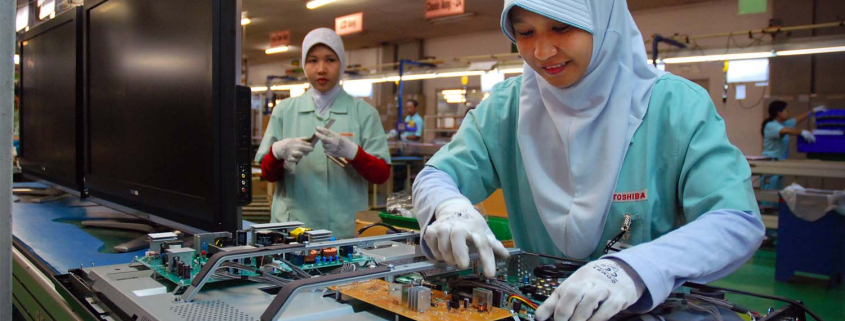ASEAN EE Industry: What Now?
Picture: Electronics factory workers in Cikarang Indonesia (© ILO/Asrian Mirza https://www.flickr.com/photos/iloasiapacific/8096440106/in/photostream/)
The heart of ASEAN’s regional economic connectivity, both in intra-regional and extra-regional trade, is the electronic and electrical (EE) industry — an industry that has provided millions of jobs and holds ASEAN’s importance in the global economy for decades. The last statistics published by ASEAN in 2015 stated that “electrical machinery and equipment and parts thereof; sound recorders and reproducers, television image and sound recorders and reproducers, and parts and accessories of such articles” the intra-regional total trade in ASEAN is USD 543,751 million and the extra-regional trade nearly tripled with the total amount of USD 1,726,558—the highest of all 99 forms of commodities.
It is no wonder, then, why ASEAN included ‘Electronics’ as its export industry focus. But should ASEAN continue to rely on its electronic industry?
The Good News: ASEAN still has time
When the Southeast Asian countries joined the trend of production-sharing or supply-chain in early 1990s that was previously done by the East Asian countries in 1980s, the success was undeniable. Trading parts and components produced by one country for further process and manufacturing have contributed Singapore, Malaysia, Thailand, and the Philippines more than 2.5 million jobs combined. The crisis in late 1990s have indeed disrupted the flow as it was in other sectors, yet it was also the first sector to recover.
For at least another decade, the electronic industry would remain a billion-dollar industry – something that ASEAN needs to take advantage from. In the Global Value Chains (GVC), the electronic industry generally has the highest value-added, second to automotive industry. In Singapore, Malaysia, Thailand, and the Philippines, the value-added is increasingly coming from domestic instead of foreign countries — meaning that the local industries are more and more involved and capable. ASEAN member-states hence have the opportunity to utilize the local industries through this chain of electronic industry. Additionally, ASEAN member-states’ purchasing power are getting stronger each year with its growing middle class, and so does the demand for electronic-related goods. Hence, albeit the demand for electronic-based goods in ASEAN depends on the parents-market in which the final-processed goods will be sent, ASEAN has the potential to make its own market for such goods.
The next good news would be, since electronic industry is chain-based, not only does the industry help ASEAN intra-regional trade, it will also strengthens the region’s economic connectivity. It has been known that, along with Non-Tariff Measures (NTM), the lack of intra-regional trade, connectivity, and development gap is still considered as the biggest challenge in realizing ASEAN Economic Community. Electronic industry, through the global value chains, have so far boosted the business connectivity, companies connectivity, and states connectivity amongst the ASEAN countries. Those advantages can surely contributes to the preparation of AEC 2025, especially if ASEAN can further involve Cambodia, Laos, and Myanmar in the scheme, remembering the economic development gap between the three countries and the rest of ASEAN member-states is still substantially high.
The Bad News: time is running out
When the ASEAN member-states first develop their electronic industry, it was export-oriented with low labour-costs as the main source of its attractiveness. This have worked for decades, but will not sustain for long. While some had argued that China’s rising labour-costs will advantage ASEAN member-states, for the better or worse, labor costs have also been rising in the region – and it will keep rising. Singapore had tasted the consequence of this back in 2011 to 2013, when there is a contraction in its electronics cluster due to the rise of labor and energy costs. This might not yet be the problem for the rest of the ASEAN member-states, but it needs to be remembered that China’s improvements in worker skill, worker productivity, and technology readiness might make The Dragon regain the cost advantage it had lost to Southeast Asia before.
The problem does not stop there. Though it has been mentioned that ASEAN has the potential to create its own electronic market — and even the possibility of an ASEAN-owned electronic brand — ASEAN’s ability to do so is questioned. Albeit there have been researches showing that technology transfer exists in the decades developing the industry, workers may only be familiar in creating their assigned components. ASEAN might be the specialty of hard-drives and semiconductors, but generally, that was all. In this case, it is necessary to applaud Malaysia who has been focusing on technology transfer to its people, making ‘technology transfer’ as a ‘recognized profession’.
Finally, full automation and artificial intelligence might still be years away, but the 4th industrial revolution (4IR) is still coming, and the electronic industry will be the industry that will either influence or get impacted the most. ASEAN has indeed embraced one of the core characteristics of 4IR, digital economy, which reflects in the ASEAN ICT Masterplan 2020 – but it has yet to have a plan on overcoming the disruption in its goods-export industry. In ASEAN member-states where electronic industry is mainly focusing on electronic components, 4IR will impact negatively on the workers. ILO reported that Indonesia, Vietnam, Cambodia, and Laos are amongst the countries which workers are very likely to be replaced in automation. ASEAN, who has the credit of ‘less-interested in developing technology’, must start to fix their priorities, go beyond hard-drives and semiconductors, and at the same time making a move in making 4IR technologies inclusive to the SMEs, as it has been mostly undertaken by MNCs and large local enterprise.
Firstya Dizka Arrum Ramadhanty is currently a Research-Intern in ASEAN Studies Center Universitas Gadjah Mada. She is also an Undergraduate Student at Department of International Relations, Faculty of Social and Political Sciences, Universitas Gadjah Mada. She is available at f.dizka@mail.ugm.ac.id.





Leave a Reply
Want to join the discussion?Feel free to contribute!